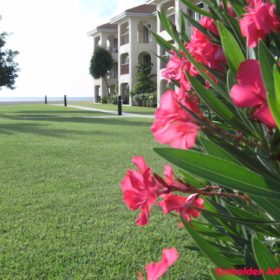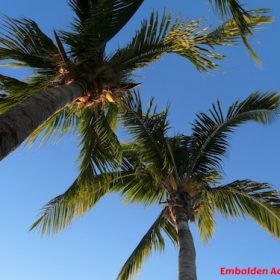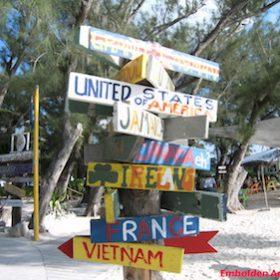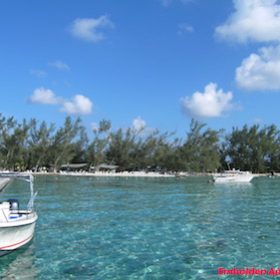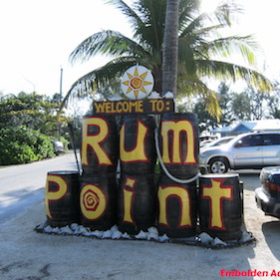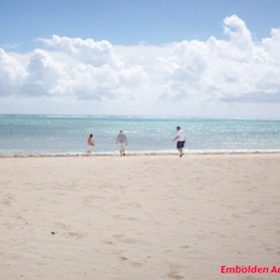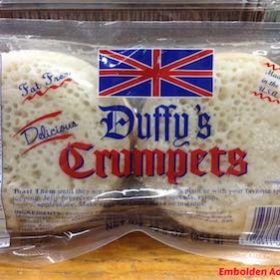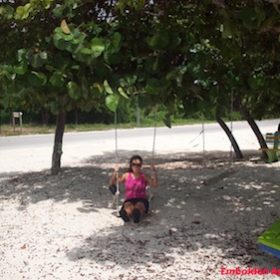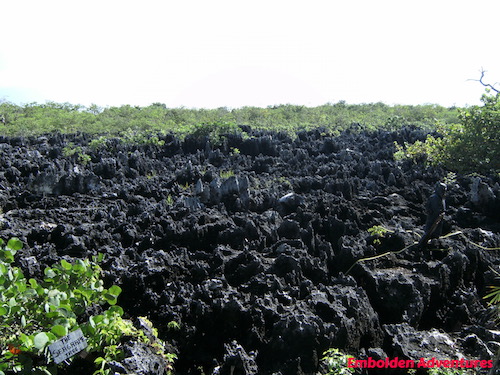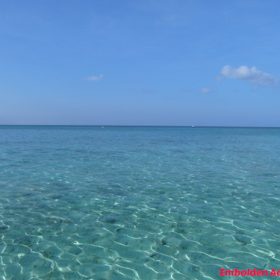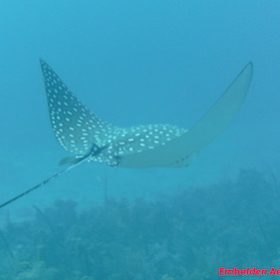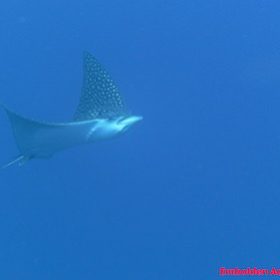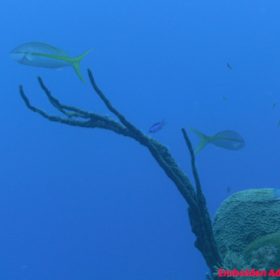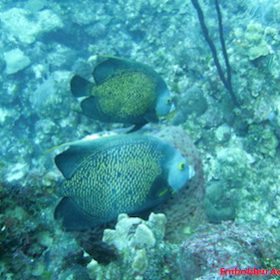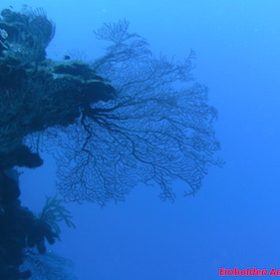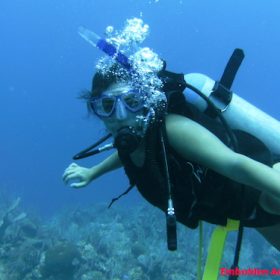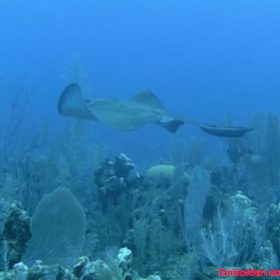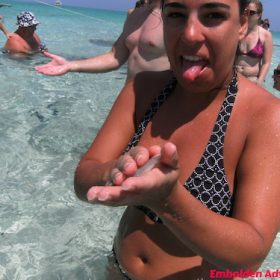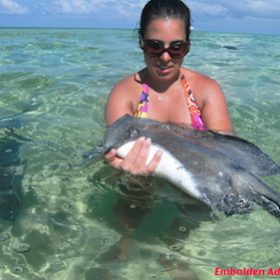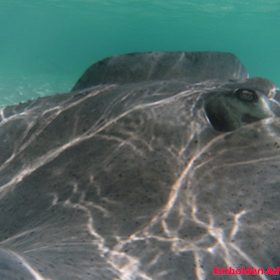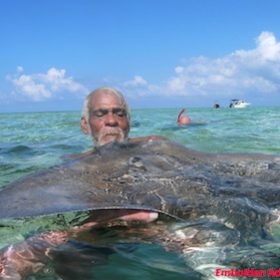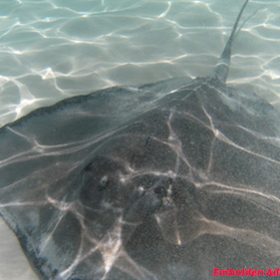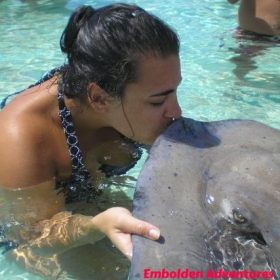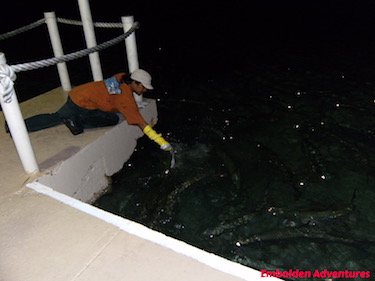Sunshine, turquoise beaches, palm trees, pastel sunsets, and…the stingrays. The Cayman Islands are a chill island destination offering the right amount of adventure and relaxation. Experience:
- A blend of American, British, and Caribbean cultures
- Scuba diving and more scuba diving
- Stingray kisses in Stingray City
- Feeding the hungry prehistoric looking tarpon
- Very long walks along the beach, Seven Mile Beach to be exact
- …and a place called
 ? Yes. Read on.
? Yes. Read on.
Ok so my brother Devin and his girlfriend Joanne do not want me to talk about this place, the Cayman Islands.
For over the last decade with more than 20 visits, the Cayman Islands have been their little bit of calming paradise.
And for me, it has been a scuba diving destination for three times and counting.
In that time it has remained under the radar more or less.
So let’s just you and me talk about the why it is worth considering a quick trip out to the Caymans. I hope that no one else is listening…
Think of it as our little secret.
For us, staying in the Caymans can be a bit like a home away from home. It is just that this home happens to be on a Caribbean island with turquoise waters and wifi.
And despite the pricy hotels, fancy resorts and lavish vacation homes on the island, a trip here with a few friends or family could be decently affordable without the hassle.
Take a short flight, rent a car at the airport, and get to your condo sublet along the shore in no time.
Non-stop flights from 13 US cities east of Dallas Texas, Toronto Canada, the Bahamas, Jamaica, Honduras and Cuba go direct to Grand Cayman. For example, the flight from New York is about 4 hours. A round-trip flight to Grand Cayman from New York could range around $250 to $600. We booked a flight for mid-December back in November and got a rate of about $280 per person.
Rental car agencies are a short walking distance from the airport. Prices range about $300 to $600 for the week. Keep in mind the traffic travels on the left side of the road.
Do not waste your dollars on a US$400+ a night room with resort fees and parking tacked onto the cost. Instead, rent a two-bedroom condo with free parking and housekeeping right at the edge of the famous Seven Mile Beach. Some two bedroom condos could rent for about $1000 to $2000 a week. Many options can be found on Cayman Villas. Popular areas like in George Town are just a short 10 to 20 minute ride from the airport.
Finally, hit up the large grocery stores and local liquor stores to stock up for the week.
So a week-long trip to Grand Cayman, not including food, gas, and incidentals, could cost about $1500 to $3500 in total.
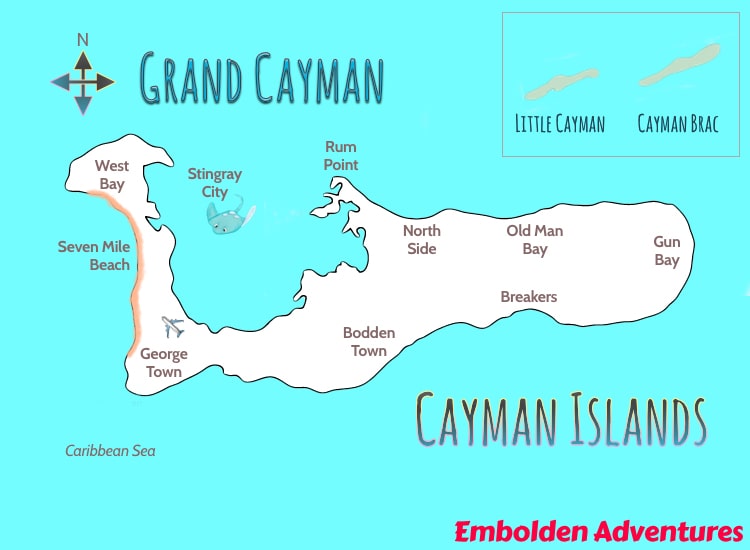
The Cayman Islands
Comprised of three islands: Grand Cayman, Little Cayman, and Cayman Brac, the Cayman Islands are a British Oversees Territory. They are located southwest to Jamaica, south to Cuba, and east of Belize and the Mexican Yucatan Peninsula. See posts and a podcast about Belize and swimming with whale sharks in Caribbean Mexico here and here.
Little Cayman and Cayman Brac are 75 miles northeast and about a 40 minute plane ride from Grand Cayman.
Grand Cayman is a popular stop along the cruise ship route around the western Caribbean. Also, they are known for the wealthy to park their assets offshore, as seen in that old Tom Cruise movie “The Firm”. Like Bermuda, many international banks and other financial institutions have offices here to support the financial industry.
The Cayman name came from explorer Sir Francis Drake who thought the iguanas on the island were Caribbean cayman crocodiles. These islands were uninhabited until the mid-1600s as British explorers from Jamaica arrived. The Cayman Islands were a colony of Jamaica until 1962 when it became a separate crown colony.
Blend of British, Caribbean, and American
Today the islands have a population of 60,000 with about 3% living on either Little Cayman or Cayman Brac. The feel is distinctly tropical British and Caribbean with touches of American.
They draw many ex-pats from the United Kingdom, Ireland, and Canada who work on the island, whether in financial services, tourism, or the restaurants and bars. Others come from Italy, France, South Africa, Jamaica, and the United States.
One of our favorite Irish pubs on the island is Fidel Murphy’s. Originally Fidel’s was a Cuban place. Actually, the name Murphy was tacked on to it after it transformed into an authentic Irish pub complete with satellite TV with UK sports channels and Irish draft beers on tap.
At the grocery store, I was pumped to see crumpets, my favorite British breakfast item, for sale. They have other British food brands and treats available too. (I posted this photo of crumpets on Facebook, displaying my utter excitement to see them in six long years since London. A friend of mine in London noticed and thought I may have been there at the time. Little did she know, I was thinking of planning a trip there, arriving in just a few short weeks. Another friend, who lived in Scotland for a while, also responded with excitement. Crumpets seem to make people happy! She too was planning a trip to the United Kingdom, the same week I would be there. Because of these crumpets, the three of us were able to make a trip to Edinburgh happen in no time. Read about the adventure here.)
Familiar fast food places to well-known resorts and hotels create a bit of an American vibe as well.
The downtown area of the island is called George Town, located on the southwest part of Grand Cayman. Souvenir shops, restaurants, and other tourist draws like our scuba shop are located here. It is an active area due to the cruise ship tourists coming from the large ships anchoring just off shore.
Escape away from the crowds though. Head north east towards Bodden Town and up to the North Side and Rum Point. Along the way, stop off at the less crowded local beaches hidden from the road.
This area has a more laid-back, Caribbean island beach bar feel with wind swept island pines, palm trees, and turquoise waters. So grab some jerk chicken, fried conch, and a frozen margarita at one of the picnic tables on the beach.
Rum Point is the northern central point of land where the bay meets the Caribbean Sea. The bay is in the form of a horseshoe shape. Its other point is the West End part of Grand Cayman. Grand Cayman looks a bit like a sneaker and Rum Point forms top part of the tongue of this “shoe”.
A Place Called 
Next head back south around the horseshoe and then up towards the West End to a place called Hell. Yes, there is a place called hell in paradise, and it is located on the northwest shore of Grand Cayman.
Grand Cayman has a few rugged iron shores around the island. The sea has eroded the limestone shore into sharp, jagged, black terrain. One area the size of a football field appears to be Hell would seem, just without the flames and eternal doom.
You can pose as Lucifer in one of the wood cut-outs or send a post card from the Hell Post Office on the premises.
Seven Mile Beach
After a visit to Hell, cool off with a visit to the Best Beach in the Caribbean. Continue down the west coast along the famous Seven Mile Beach. This beach is just that, a seven mile stretch of perfect tropical beach with pristine sand and palm trees. The water is calm and at times as flat as glass. Many high end resorts and outdoor beach bars line the way. Taking a stroll you just may see a destination wedding in action by the water’s edge.
The best part though is watching the sunset over the horizon. A gorgeous ombre of pastel pinks, oranges, yellows, blues and more color the sky and reflect on the water.
www.youtube.com/embed/RDm8AcbPymU
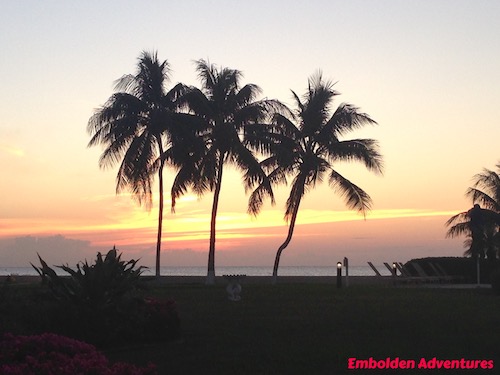
Scuba Diving Mecca
Besides the beaches and the sun, another draw to the Cayman Islands is the scuba diving.
These three islands have unique underwater terrain and vibrant corals resulting in a scuba diving hot spot in the Caribbean. Diving sites are plentiful and vary from shallow coral dives to wreck diving to deep dives along underwater cliffs.
Grand Cayman, Little Cayman, and Cayman Brac sit between two tectonic plates, the North American and Caribbean plates. These plates separate rather than collide, causing deep underwater trenches. The most notable is the Cayman Trench with a maximum depth of over 25,000 feet. Because of these trenches, the sea floor around the island drops off significantly, making for great deep dives along the coral sea walls.
Nutrient-rich upwells from depths of 2,000 to 3,000 feet support a diverse underwater ecosystem around the islands. When diving “off the wall” I have seen spotted eagle rays and a very shy hammerhead shark. Every so often a whale shark or manta ray has been known to pass by in the area.
In addition to the wall dives, the Cayman Islands have a few underwater shipwrecks to explore. The most notable wreck dive is the US Navy ship, the USS Kittywake. This ship was sunk in 2011 at the northwest tip of the island near West Bay. Over time, a diverse underwater ecosystem will develop as this wreck is intended to become an artificial reef system. Since this wreck is an attraction, the Cayman Islands Tourism Association charges an $8.00 fee for divers and a $4.00 fee for snorkelers. I vaguely recall doing this dive a while ago and remember it to be like any large wreck dive.
Another popular wreck dive is the Oro Verde just 100 yards off the west shore of Grand Cayman in 50 feet of water. We learned on one of our dives that this boat was in the banana business but was also running a drug business on the side in the 1980s. Eventually, the crew discovered the captain’s side business and wanted involvement. The captain refused and so they murdered him and then threw him overboard. The boat later ran aground towards the south side of the island. Finally, it was towed to the west shore for the purpose of creating a dive site.
Scores of dive sites are close to shore and surround the entire island of Grand Cayman. The more popular areas are located along the west and north part of the island, although in the late fall and winter months the seas in the north are choppier.
The islands of Little Cayman and Cayman Brac tend to have better dive sites undisturbed and rich with sea life. Getting to these islands, though, would require a long boat ride or a short puddle-jumper plane from Grand Cayman.
Lately due to overfishing and run-off from the on-going construction on the island, the conditions of the reefs around Grand Cayman are deteriorating. Over the last decade or so, Grand Cayman Island has become more crowded with cars, people and new buildings as observed by my brother and Joanne. For this reason, we want to keep this secret safe with us.
I dove Grand Cayman first in 2009, again in 2010, and recently in 2016. Consequently, I noticed the change for myself: I see less fish and no sharks.
Of the many dives I did in Cayman, one in 2010 was an experience for my record books. We went scuba diving in the edge of a tropical storm one morning. At the time, Tropical Storm Paula was pushing up the coast of Belize and the Yucatan Peninsula in Mexico, about 500 mile west from Grand Cayman. The outer bands of the storm were beginning to move over the Cayman Islands.
Usually the Cayman Islands are spared from hurricanes and tropical storms in the Caribbean due to their western location. They did have one direct hit from a big Category 5 hurricane, Hurricane Ivan, back in September 2004. Hurricane Ivan destroyed buildings, ripped off rooftops, and caused massive flooding. The coral reefs were impacted too.
Large storms like Ivan have not wrecked as much havoc in recent years. Although just our luck, we felt the effects of Tropical Storm Paula while we were visiting Grand Cayman.
In the morning during our first dive, the sky appeared to be overcast, so we went for it. By the time we were on our second dive, underwater became as dark as a dive at sunset. The sky turned black from the thunderclouds. As we ascended to shallower water for our safety stop, we could see the raindrops from the now torrential downpour hit the surface of the water. The ocean was becoming very choppy and the boat above us was rocking and rolling.
Obviously it was time to head back to shore but our boat operator now had no visual markers. The horizon was entirely greyed-out from the choppy waves and the sheet of rain hitting the water. We happened to witness a few lightening bolts touch down to the water just hundreds of feet away.
To navigate back, the boat operator had to use a scuba diving compass. His partner shielded the compass with a dive card, protecting its view from the wind and torrential rain falling sideways. We zigzagged through the expansive water trying to locate the marina. The rain was so strong from the storm and from the speedboat that we had to keep our dive masks and wetsuits on to endure the elements. It took us 3 times longer that usual to make it back to the marina. This experience was quite a trip!
More so, we had a dive student on the boat completing his open water dives for the day. Poor guy. He was freezing in just his bathing suit and hiding under a soaked towel. I hope this crazy dive experienced did not deter him from diving going forward as a result.
Despite the excitement of the occasional tropical storm or hurricane, dive conditions tend to be calm with minimal current. For this reason, Grand Cayman is a good dive destination for the beginner diver like me back in late 2009 when I only had a handful of dives. Now I have approximately 250 dives and became rescue dive certified.
Underwater visibility is about 50 to 100 feet or more. Water temperatures range from high 70s to mid-80s in the summer although this past December 2016, the water was a few degrees warmer at around 83 degrees Fahrenheit. Warmer water supports longer life spans of the algae on the corals. That, and with less reef fish that eat the algae, the coral could die more rapidly from algae growth.
The less sharks and predator fish like groupers are on the reefs, the more the mid-size fish populate the reef. These mid-size fish eat the smaller reef fish that, in turn, feed on the algae on the coral reef. Either way, the corals have not seemed as vibrant to me as of late.
So lets save our sharks and be more responsible with our fishing. Lets be better stewards of our environments on land so we protect our reefs at sea. And lets add more old ships to create artificial habitats to spur more coral growth.
Although a good thing that the Cayman Islands do have are plenty of stingrays swimming around in the turquoise waters
Sting Ray City
So a fun draw in Grand Cayman is a city of stingrays, better known as Sting Ray City. The area is located in the bay north of the island and protected from the Caribbean Sea.
Sting Ray City is actually two “cities” where wild stingrays congregate in shallow waters. The first is a shallow underwater sandbar only a few feet deep. The second is a scuba dive site in about 30 to 50 feet of water. Both are places people can go to feed the stingrays by hand. These stingrays love frozen squid!
A long time ago local fishermen would park themselves in the calm bay to clean their catches of the day. Eventually the stingrays caught on that a meal of fish parts was waiting for them. Over time they got used to the human touch, and now they are at Sting Ray City every day waiting for a free meal.
To access Sting Ray City, take a charter boat from the marina out into the bay. Tourists can get in the water waste high to feed the stingrays.
The stingrays are as excitable like puppy dogs…well slippery, wet puppy dogs. Don’t worry that they are related to the shark family, these fish are docile and have no teeth. Rather, they have a cartilage ridge that feels like sandpaper.
The stingrays are swimming around and through the legs of the people eagerly awaiting a treat or two. Some bold ones even come right up to you at the surface.
Frozen squid is their favorite. Once they sense it on you, they go wild. When you feed them squid, they suck it right out of the fist of your hand. So I chummed my camera so that they could come up to the lens for an up close shot.
Visiting Sting Ray City is worth the experience, because not many places around the world have these opportunities to interact with these fun creatures. Who knows, maybe you will even get a kiss from one of them.
Prehistoric Looking Tarpon
Make one additional sea creature stop at the Wharf Restaurant near downtown George Town to see the tarpon. Tarpon are these long, slender, silvery fish about 6 feet in length. They have one ugly under bite and menacing looking eyes. To me they look prehistoric as if they lived during the dinosaur days but maybe resembling a huskier barracuda instead.
Typically tarpon hide in underwater coral overhangs or in underwater caves. I saw one hiding the shallow waters when I was diving the Cheeseburger Reef dive site, named because of its proximity to the Burger King in downtown George Town. Nowadays the tarpon have grown lazy, congregating by the Wharf Restaurant’s waterfront dining area.
Towards the end of dinnertime, the staff rings a bell near the dock, summoning the tarpon. Then they drop scrap fish and other tarpon delicacies into water. Watch as the tarpon break through the surface of the water and fight one another for these tasty meals.
And that is a wrap. From crumpets to jerk chicken, from hell to paradise, from sting rays to tarpon, the Cayman Islands provide a blend of mild adventure and a relaxing few days away from the grind.


